Abstract
In recent years, there is a massive demand for the development of high-performance sensing technologies to curtail the effect of environmental pollutions. One such primary ecological concern is water pollution, where the major risk factor is associated with the concentrations of the chemical residues (hydrogen peroxide [H2O2]) in drinking water. Keeping this in view, we have demonstrated a non-enzymatic electrochemical probing of H2O2 in water employing microwave-assisted TiO2-ZrO2-HfO2 ternary nanocomposite for the first time. Structural analysis revealed the formation of monoclinic phases of ZrO2 and HfO2 along with anatase phased TiO2. Dynamic sensing characteristics of the TiO2-ZrO2-HfO2 nanocomposite were studied by varying the concentration of H2O2 from 1 to 19 µM where the sensor showed linearity up to 9 µM. The LOD and LOQ of the sensor were found to be 0.32 and 1.06 µM respectively along with the sensitivity of 6.71 \(\mu \mathrm{A}\bullet\upmu {\mathrm{M}}^{-1}\). The dominant signal change of Zr4+ ions in the TiO2-ZrO2-HfO2 nanointerface upon interacting with H2O2 has significantly inhibited the Hf4+ ions from taking part in the redox reaction, which refers to the sacrificial behavior. The reaction hierarchy was observed as ZrO2 (Eo = − 1.23 V) > TiO2 (Eo = − 1.15 V [suppressed peak]) > HfO2 (no redox peaks observed sacrificial). The real-time recovery study was carried out using the tap water, field water, and urban river water samples with repeatable and reproducible characteristics. Thus, our study provokes a new dimension in exploring many ternary nanointerfaces in the near future for the electrochemical sensing of different analytes.
Graphical abstract






Similar content being viewed by others
References
Afraz, A., Rafati, A. A., & Hajian, A. (2013). Analytical sensing of hydrogen peroxide on Ag nanoparticles–multiwalled carbon nanotube-modified glassy carbon electrode. Journal of Solid State Electrochemistry, 17(7), 2017–2025. https://doi.org/10.1007/s10008-013-2057-8
Ainla, A., Mousavi, M. P. S., Tsaloglou, M. N., Redston, J., Bell, J. G., Fernández-Abedul, M. T., & Whitesides, G. M. (2018). Open-source potentiostat for wireless electrochemical detection with smartphones. Analytical Chemistry, 90(10), 6240–6246. https://doi.org/10.1016/j.snb.2017.10.076
Alagappan, L. P., Shanmugasundaram, P., Ramachandra, B. L., Gumpu, M. B., Nesakumar, N., Jayanth Babu, K., et al. (2017). Fabrication of electrochemical biosensor with vanadium pentoxide nano-interface for the detection of methylglyoxal in rice. Analytical Biochemistry, 528, 19–25. https://doi.org/10.1016/j.ab.2017.04.010
Al-taweel, S. S., & Saud, H. R. (2016). New route for synthesis of pure anatase TiO2 nanoparticles via utrasound-assisted sol-gel method. Journal of Chemical and Pharmaceutical Research, 8(2), 620–626.
Bai, X., Chen, G., & Shiu, K. K. (2013). Electrochemical biosensor based on reduced graphene oxide modified electrode with Prussian blue and poly(toluidine blue O) coating. Electrochimica Acta, 89, 454–460. https://doi.org/10.1016/j.electacta.2012.11.086
Cai, B., Zhao, M., Wang, Y., Zhou, Y., Cai, H., Ye, Z., & Huang, J. (2014). A perovskite-type KNbO3 nanoneedles based biosensor for direct electrochemistry of hydrogen peroxide. Ceramics International, 40(6), 8111–8116. https://doi.org/10.1016/j.ceramint.2014.01.005
Chen, H., & Dong, S. (2007). Direct electrochemistry and electrocatalysis of horseradish peroxidase immobilized in sol-gel-derived ceramic-carbon nanotube nanocomposite film. Biosensors and Bioelectronics, 22(8), 1811–1815. https://doi.org/10.1016/j.bios.2006.08.013
Chougala, L. S., Yatnatti, M. S., Linganagoudar, R. K., Kamble, R. R., & Kadadevarmath, J. S. (2017). A simple approach on synthesis of TiO2 nanoparticles and its application in dye sensitized solar cells. Journal of Nano- and Electronic Physics, 9(4). https://doi.org/10.21272/jnep.9(4).04005.
Ghabach, M., & Davarpanah, A. H. (2020). Hydrogen peroxide poisoning. The Lancet Gastroenterology and Hepatology, 5(4), 418. https://doi.org/10.1016/S2468-1253(20)30003-0
Ghamsari, M. S., Gaeeni, M. R., Han, W., & Park, H.-H. (2017). Efficient blue luminescence from HfO2 colloidal nanocrystals. Materials Express, 7(1), 72–78. https://doi.org/10.1166/mex.2017.1347
Huang, Y. Y., & Lin, L. Y. (2018). Synthesis of ternary metal oxides for battery-supercapacitor hybrid devices: Influences of metal species on redox reaction and electrical conductivity. ACS Applied Energy Materials, 1(6), 2979–2990. https://doi.org/10.1021/acsaem.8b00781
Jafarpour, M., Rezapour, E., Ghahramaninezhad, M., & Rezaeifard, A. (2014). A novel protocol for selective synthesis of monoclinic zirconia nanoparticles as a heterogeneous catalyst for condensation of 1,2-diamines with 1,2-dicarbonyl compounds. New Journal of Chemistry, 38(2), 676–682. https://doi.org/10.1039/c3nj00655g
Jamal, M., Xu, J., & Razeeb, K. M. (2010). Disposable biosensor based on immobilisation of glutamate oxidase on Pt nanoparticles modified Au nanowire array electrode. Biosensors and Bioelectronics, 26(4), 1420–1424. https://doi.org/10.1016/j.bios.2010.07.071
Krishnakumar, A., Srinivasan, P., Kulandaisamy, A. J., Babu, K. J., & Rayappan, J. B. B. (2019). A facile microwave synthesis of rGO, ZrO2 and rGO–ZrO2 nanocomposite and their room temperature gas sensing properties. Journal of Materials Science: Materials in Electronics, (0123456789). https://doi.org/10.1007/s10854-019-02056-8.
Lee, M., Zine, N., Baraket, A., Zabala, M., Campabadal, F., Caruso, R., et al. (2012). Sensors and Actuators B : Chemical A novel biosensor based on hafnium oxide: Application for early stage detection of human interleukin-10. Sensors & Actuators: b. Chemical, 175, 201–207. https://doi.org/10.1016/j.snb.2012.04.090
Li, F., Luo, S., Sun, Z., Bao, X., & Fan, L. S. (2011). Role of metal oxide support in redox reactions of iron oxide for chemical looping applications: Experiments and density functional theory calculations. Energy and Environmental Science, 4(9), 3661–3667. https://doi.org/10.1039/c1ee01325d
Li, Y., Li, Y., & Yang, Y. (2012). A new amperometric H2O2 biosensor based on nanocomposite films of chitosan–MWNTs, hemoglobin, and silver nanoparticles. Journal of Solid State Electrochemistry, 16(3), 1133–1140. https://doi.org/10.1007/s10008-011-1503-8
Li, Z., Leung, C., Gao, F., & Gu, Z. (2015). Effects of nanowire length and surface roughness on the electrochemical sensor properties of nafion-free, Vertically aligned pt nanowire array electrodes. Sensors (switzerland), 15(9), 22473–22489. https://doi.org/10.3390/s150922473
Manivel, A., & Anandan, S. (2011). Silver nanoparticles embedded phosphomolybdate–polyaniline hybrid electrode for electrocatalytic reduction of H2O2. Journal of Solid State Electrochemistry, 15(1), 153–160. https://doi.org/10.1007/s10008-010-1080-2
Meng, F., Yan, X., Liu, J., Gu, J., & Zou, Z. (2011). Nanoporous gold as non-enzymatic sensor for hydrogen peroxide. Electrochimica Acta, 56(12), 4657–4662. https://doi.org/10.1016/j.electacta.2011.02.105
Miao, Y., & Tan, S. N. (2001). Amperometric hydrogen peroxide biosensor with silica sol-gel/chitosan film as immobilization matrix. Analytica Chimica Acta, 437(1), 87–93.
Mogha, N. K., Sahu, V., Sharma, M., Sharma, R. K., & Masram, D. T. (2016). Biocompatible ZrO2- reduced graphene oxide immobilized AChE biosensor for chlorpyrifos detection. Materials & Design, 111, 312–320. https://doi.org/10.1016/S0003-2670(01)00986-2
Murphy, M., Walczak, M. S., Hussain, H., Acres, M. J., Muryn, C. A., Thomas, A. G., et al. (2016). An ex situ study of the adsorption of calcium phosphate from solution onto TiO2 (110) and Al2O3 (0001). Surface Science, 646(September), 146–153. https://doi.org/10.1016/j.susc.2015.08.040
Nalini, S., Nandini, S., Shanmugam, S., Neelagund, S. E., Melo, J. S., & Suresh, G. S. (2014). Amperometric hydrogen peroxide and cholesterol biosensors designed by using hierarchical curtailed silver flowers functionalized graphene and enzymes deposits. Journal of Solid State Electrochemistry, 18(3), 685–701. https://doi.org/10.1007/s10008-013-2305-y
Padma Kumar, H., Vidya, S., Saravana Kumar, S., Vijayakumar, C., Solomon, S., & Thomas, J. K. (2015). Optical properties of nanocrystalline HfO2 synthesized by an auto-igniting combustion synthesis. Journal of Asian Ceramic Societies, 3(1), 64–69. https://doi.org/10.1016/j.jascer.2014.10.009
Pipi, A., Byzynski, G., & Ruotolo, L. (2017). Photocatalytic activity and RNO dye degradation of nitrogen-doped TiO2 prepared by ionothermal synthesis. Materials Research, 20(3), 628–638. https://doi.org/10.1590/1980-5373-mr-2016-0837
Ramadoss, A., Krishnamoorthy, K., & Kim, S. J. (2012). Novel synthesis of hafnium oxide nanoparticles by precipitation method and its characterization. Materials Research Bulletin, 47(9), 2680–2684. https://doi.org/10.1016/j.materresbull.2012.05.051
Rani, S., Aggarwal, M., Kumar, M., Sharma, S., & Kumar, D. (2016). Removal of methylene blue and rhodamine B from water by zirconium oxide/graphene. Water Science, 30(1), 51–60. https://doi.org/10.1016/j.wsj.2016.04.001
Salah, N., Habib, S. S., Khan, Z. H., & Djouider, F. (2011). Thermoluminescence and photoluminescence of ZrO2 nanoparticles. Radiation Physics and Chemistry, 80(9), 923–928. https://doi.org/10.1016/j.radphyschem.2011.03.023
Sunday, M. O., Jadoon, W. A., Ayeni, T. T., Iwamoto, Y., Takeda, K., Imaizumi, Y., et al. (2020). Heterogeneity and potential aquatic toxicity of hydrogen peroxide concentrations in selected rivers across Japan. Science of the Total Environment, 733, 139349. https://doi.org/10.1016/j.scitotenv.2020.139349
Thermo science. Hafnium oxide XPS simplified. Thermoscience. https://xpssimplified.com/elements/hafnium.php. Accessed 7 Apr 2020.
Understanding the Oxygen Release at High Potential for Transition Metal Oxides. (2018). ECS Meeting Abstracts.
Wang, J., Cui, L., Yin, H., Dong, J., & Ai, S. (2012). Determination of hydrogen peroxide based on calcined layered double hydroxide-modified glassy carbon electrode in flavored beverages. Journal of Solid State Electrochemistry, 16(4), 1545–1550. https://doi.org/10.1007/s10008-011-1551-0
Wang, J., Xu, G., Zhang, X., Lv, J., Zhang, X., Zheng, Z., & Wu, Y. (2015). Electrochemical performance and biosensor application of TiO2 nanotube arrays with mesoporous structures constructed by chemical etching. Dalton Transactions, 44(16), 7662–7672. https://doi.org/10.1039/c5dt00678c
Wang, Y., Zhang, H., Yao, D., Pu, J., Zhang, Y., Gao, X., & Sun, Y. (2013). Direct electrochemistry of hemoglobin on graphene/Fe3O4 nanocomposite-modified glass carbon electrode and its sensitive detection for hydrogen peroxide. Journal of Solid State Electrochemistry, 17(3), 881–887. https://doi.org/10.1007/s10008-012-1939-5
Wing, Z. N., & Halloran, J. W. (2006). Fabrication and properties of an anisotropic TiO2 dielectric composite, 2815, 2812–2815. https://doi.org/10.1111/j.1551-2916.2006.01134.x.
Wu, L. Q., Li, Y. C., Li, S. Q., Li, Z. Z., Tang, G. D., Qi, W. H., et al. (2015). Method for estimating ionicities of oxides using O1s photoelectron spectra. AIP Advances, 5(9), 7. https://doi.org/10.1063/1.4931996
Wu, R., Chen, X., & Hu, J. (2012). Synthesis, characterization, and biosensing application of ZnO/SnO2 heterostructured nanomaterials. Journal of Solid State Electrochemistry, 16(5), 1975–1982. https://doi.org/10.1007/s10008-011-1590-6
Yang, W., Xu, W., Wang, Y., Chen, D., Wang, X., Cao, Y., et al. (2020). Photoelectrochemical glucose biosensor based on the heterogeneous facets of nanocrystalline TiO2 /Au/glucose oxidase films. ACS Applied Nano Materials, 3(3), 2723–2732. https://doi.org/10.1021/acsanm.0c00086
Zhao, H. C., Zhang, P., Li, S. H., & Luo, H. X. (2017). Cobalt hexacyanoferrate-modified graphene platform electrode and its electrochemical sensing toward hydrogen peroxide. Chinese Journal of Analytical Chemistry, 45(6), 830–836. https://doi.org/10.1016/S1872-2040(17)61018-1
Zhu, Y.-J., & Chen, F. (2014). Microwave-assisted preparation of inorganic nanostructures in liquid phase. Chemical Reviews, 114(12), 6462–6555. https://doi.org/10.1021/cr400366s
Acknowledgements
The authors wish to express their sincere thanks to the Micro/Nano Technology Center (MNTC), Tokai University (Shonan Campus), Japan, for their infrastructural and financial support. The authors express their sincere thanks to Tokai Imaging Center for Advanced Research (TICAR), Tokai University (Shonan campus), Japan, for additional characterization techniques. The authors also acknowledge SASTRA Deemed University, India, for extending infrastructure support to carry out this work.
Author information
Authors and Affiliations
Contributions
A.K. synthesized and characterized the nanocomposite, performed electrochemical studies interpreted sensing mechanism, and drafted the manuscript; P.S. synthesized analyzed data and drafted the manuscript; G.K.M. performed characterization and manuscript revision; R.K. performed formal analysis and analyzed the experimental procedure; K.O. analyzed the electrochemical data; J.B.B. analyzed, supervised, and drafted the manuscript; K.T. planned the funding, supervision, and manuscript revision.
Corresponding author
Ethics declarations
Competing Interests
The authors declare that they have no competing interests.
Additional information
Publisher's Note
Springer Nature remains neutral with regard to jurisdictional claims in published maps and institutional affiliations.
Research Highlights
• Electrochemical detection of H2O2 using TiO2-ZrO2-HfO2 nanointerface
• Sacrificial behavior of Hf4+ ions is observed during redox behavior
• Linear range of 1–9 μM with a sensitivity of 6.71 μA μM−1
• LOD and LOQ of the sensor are 0.32 and 1.06 μM respectively
• Validation using the recovery study in field, tap, and urban river water
Rights and permissions
About this article
Cite this article
Krishnakumar, A., Srinivasan, P., Mani, G.K. et al. Electrochemical Probing of H2O2 Using TiO2-ZrO2-HfO2 Modified Glassy Carbon Electrode: A Promoted Sacrificial Behavior of Hf4+ ions. Water Air Soil Pollut 232, 262 (2021). https://doi.org/10.1007/s11270-021-05190-4
Received:
Accepted:
Published:
DOI: https://doi.org/10.1007/s11270-021-05190-4




